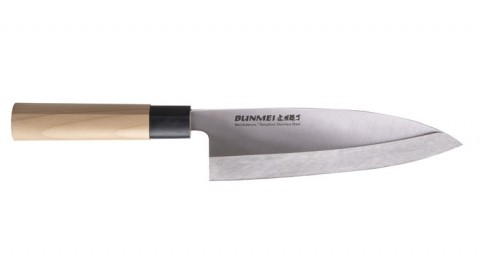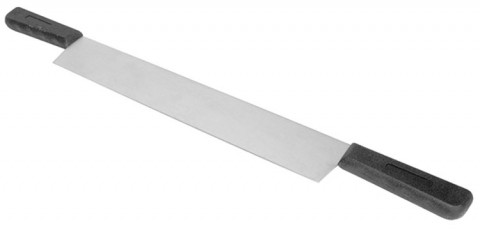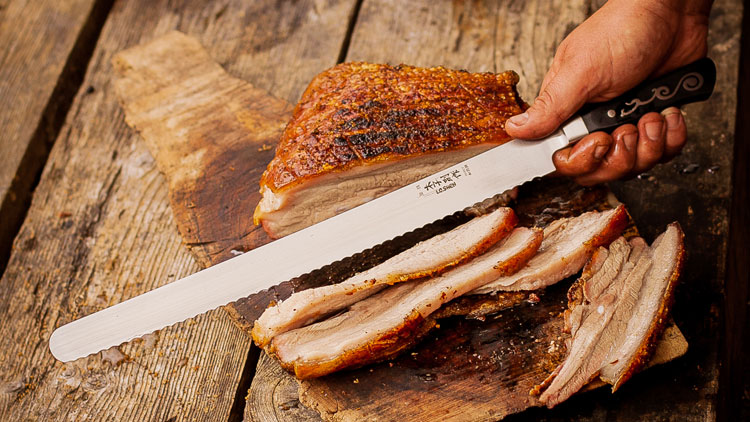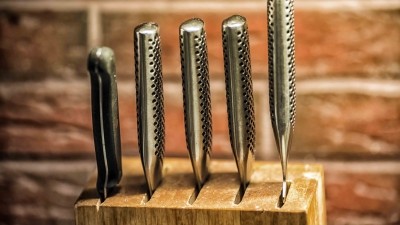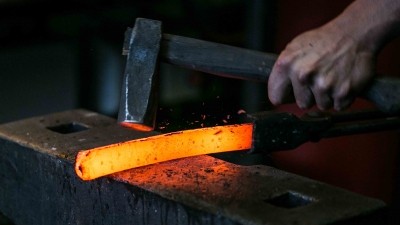Nine niche knives you didn't know you needed
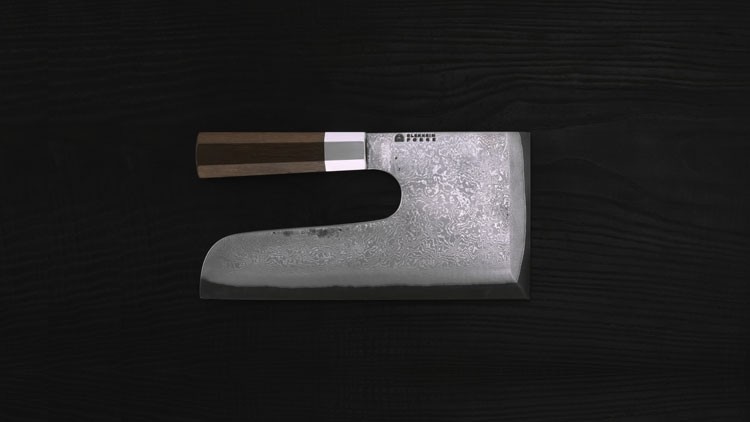
Blenheim Forge Sobakiri
As the name hints, this beast of a blade (pictured above) is designed for cutting up soba noodles. To make soba, dough is flattened and folded, and then cut with the sobakiri using a slight forward motion to produce long rectangular noodles.
Forged under a railway arch in Peckham, the knife has heft to allow it to effortlessly glide through the dough, and could also be used to make udon noodles (although purists would say you need an udonkiri for that task). We suspect it would also be a useful for pasta work – especially tagliatelle – but priced at a heady £1,300 this is a knife for those who take their noodle slicing very seriously indeed.
Bunmei Deba
Robust and hefty enough to sever fish heads and hack through poultry bones, the deba is a good fit for chefs on sauce and fish sections. Grunwerg says this particular knife is especially well suited to fish butchery. Debas are becoming increasingly popular with western chefs as the shape and slicing action is comparable to that of a chef’s knife. With a molybdenum and vanadium stainless steel blade, and a slip resistant handle,
the knife is available in five different lengths, from 105mm to 225mm.
Vogue Double Handled Cheese Cutter 38cm
An essential piece of kit for restaurants dealing with large chunks of cheese, this knife’s two-handed design allows chefs to exert force onto larger blocks without the risk of badly cutting fingers, a common injury when dealing with unwieldy ingredients. The 38cm knife features ergonomic handles and a premium blade constructed from high-quality stainless steel and ground to a razor-sharp edge, ensuring long-lasting durability.
Vogue Garnishing Set
Those looking to fashion flowers from carrots and carve watermelons into owls need look no further than Vogue’s 22-piece Garnishing Set. It includes carving tools, paring knives, a fruit and vegetable decorator, a doublesided fruit and vegetable scoop, a bird’s beak knife, a pointer, stripper and a crinkle cutter. Nisbets also does an 80-piece set for those looking to take their food sculpturing game to even greater heights.
I.O.Shen knives Mizu Slicer
Designed with barbecue maestros front of mind, the Mizu Slicer (pictured above) has a serrated edge that – according to I.O.Shen managing director Natalie Clifton – cuts through crackling and bark “like a lightsaber”. The product has an extra-long 36cm Triplex scalloped serrated blade that can be used to tackle very large cuts of meat. The knife was designed in partnership with British barbecue gurus Alvin Harris (aka DrSweetSmoke) and Marcus Bawdon, the editor of UK BBQ Mag. Those looking to channel their inner Luke Skywalker will need to fork out £129.
De Buyer FK2 Salmon and Ham Santoku Knife
The FK2 range of professional knives by French brand De Buyer is said to combine the best of German and Japanese blades for a winning mix of strength and sharpness. Flexible and with small dimples to reduce friction, the salmon and ham santoku knife is made from German stainless steel alloy (X50CrMoV15, if you were wondering) hardened and tempered to HRC56. It’s a tool designed for prolonged use with a special handle that allows chefs to adjust the balance of the knife by unscrewing the end of the handle and removing counterweight spacers.
Dick 1905 Herb and Parmesan Knife
Stop sniggering at the back. This 30cm knife (pictured right) has a distinctive almond-shaped blade that is perfectly suited to e fortlessly rolling over herbs (it’s designed to be used with just one hand, leaving the other free to deftly hold the herbs in place). The blade is made from a razor sharp and extremely durable German steel, making it a good bet for crushing ingredients like garlic. As the name suggests, it’s tough enough to be used for digging and prising out parmesan from whole wheels.
dick.de
Savernake Knives G&T Slicer
At £220 a pop, it’s debatable whether Savernake’s G&T Slicer is “the perfect stocking filler for people that take pride in the art of crafting a superb drink”, but it’s certainly a beautiful object. Savernake founders Laurie Timpson and Phillip Shaw were apparently moved to create the knife after witnessing a bartender at their local butchering a lemon with a blunt blade. Like the rest of the Wiltshire-based company’s output, the knife can be customised with different blade finishes, handles and engravings.
Hygiplas Serrated Tomato Knife
These thrifty little knives command a place in everyone’s knife roll. As advertised, the razor-sharp blade makes short work of tomatoes but it’s also a good option for bar prep (its blunt tip is a handy safety feature for those not used to handling a sharp knife). It’s dishwasher proof and easy to sharpen, but the cost is so low, most chefs simply buy another one when the blade dulls.
The Insider
Dean Starling, brand sales development chef, Nisbets
Which knife purchasing trends are you seeing at the moment?
Younger chefs tend to choose knives with no bolster, which often feature on eastern-style knives. Handles with natural materials or unique features are becoming very popular as chefs look for bespoke and individual knives and something that stands out. Hidden knife tangs are also becoming popular among younger chefs, another thing that is influenced by Japanese knives.
Are there any innovations in knife manufacture techniques?
Knife manufacturing techniques are always changing as brands look to cater to the ever-growing market. There has also been a massive surge in chefs wanting their main knife to be special and unique to them. This has led to a number of companies boasting ‘old knife craftsman’s skills’ to offer a bespoke knife service.
There are lots of different ways to sharpen a knife. What’s your advice?
A key aspect to consider is that soft steel knives require more sharpening because they lose their edge quicker, and hard steel knives, despite lasting longer, will require a longer sharpening regime once their edge starts to deteriorate. It’s important to keep a knife sharp, but sharpening knives with a diamond steel after every use is not good practice as it causes excessive wear. Instead, use a diamond steel for sharpening once a week and a normal steel to sharpen once a day. If you find the edge is not coming back, introduce a whetstone.
What three key pieces of advice would you give to chefs purchasing a knife set?
Choose between soft or hard steel, and choose the right knife for the job. For example, use a single bevel knife for delicate slicing and not for heavy chopping and prep work, and keep a double bevel knife for more vigorous work. Consider German or Japanese-style knives. The German style is better for a rocking, cutting technique and Japanese style is best for a vertical cutting technique. When it comes to purchasing a set, consider the handle and its bolster/ non-bolster because balance is key.
This article first appeared in the December 2018 issue of Restaurant magazine, the leading title for the UK's restaurant industry. For more features, comment, interviews and in-depth analysis of the sector subscribe to Restaurant magazine here.
